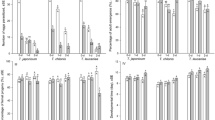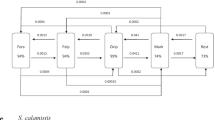Abstract
The ability of female parasitoids (Chelonus insularis Cresson,Telenomus heliothidis Ashmead, andTrichogramma pretiosum Riley) to distinguish between parasitized and unparasitized tobacco budworm,Heliothis virescens (F.), eggs was determined in laboratory studies. All 3 species were relatively efficient at detecting eggs that were previously parasitized by conspecific females.T. heliothidis andT. pretiosum were able to discriminate on the basis of external examination of host eggs, whereasC. insularis appeared to examine hosts internally as well as externally. In interspecific tests, no species readily rejected eggs parasitized by the other 2 species.
Résumé
L'aptitude des femelles parasitoides (Chelonus insularis Cresson,Telenomus heliothidis Ashmead, etTrichogramma pretiosum Riley) à discerner les œufs de «vers du bourgeon» du tabac,Heliothis virescens (F.), qui sont parasités de ceux qui ne le sont pas, a été analysée par des études de laboratoire. Les 3 espèces ont été relativement efficaces en distinguant les œufs qui avaient été parasités auparavant par des femelles conspécifiques.Telenomus heliothidis etTrichogramma pretiosum pouvaient les discerner par examen externe tandis queC. insularis semblait pouvoir discerner les hôtes parasités par examen externe ou interne. Dans des essais interspécifiques, chacune des espèces a distingué faiblement les œufs parasités par les 2 autres espèces.
Similar content being viewed by others
References
Gerling, D. &Schwartz, A.—1974. Host selection byTelenomus remus, a parasite ofSpodoptera littoralis eggs.—Entomol. Exp. Appl., 17, 391–396.
Greany, P. D. &Oatman, E. R.—1972. Analysis of host discrimination in the parasiteOrgilus lepidus [Hymenoptera: Braconidae].—Ann. Entomol. Soc. Am., 65, 377–383.
Klomp, H. &Teerink, B. J.—1978. The elimination of super-numerary larvae of the gregarious egg-parasitoidTrichogramma embryophagum [Hym.: Trichogrammatidae] in eggs of the hostEphestia kuehniella [Lep.: Pyralidae]—Entomophaga, 23, 153–159.
Lenteren, J. C. van.—1976. The development of host discrimination and the prevention of superparasitism in the parasitePseudeucolia bochei Weld [Hym.: Cynipidae].—Neth. J. Zool., 26, 1–83.
Morrison, R. K.—1970. A simple cage for maintaining parasites.—Ann. Entomol. Soc. Am., 63, 625–626.
Rabb, R. L. &Bradley, J. R.—1970. Marking host eggs byTelenomus sphingis.—Ann. Entomol. Soc. Am., 63, 6053–1056.
Safavi, M.—1968. Étude biologique et écologique des hyménoptères parasites des œufs des punaises des céréales.—Entomophaga, 13, 381–495.
Salt, G.—1934. Experimental studies in insect parasitism. II. Superparasitism.—Proc. R. Entomol. Soc. Lond., B., 114, 455–476.
—1937. The sense used byTrichogramma to distinguish between parasitized and unparasitized hosts.—Proc. R. Entomol. Soc. Lond., B, 122, 57–75.
Smith, H. S.—1916. An attempt to redefine the host relationships exhibited by entomophagous insects.—J. Econ. Entomol., 9, 477–486.
Steel, R. G. D. &Torrie, J. H.—1960. Principles and Procedures of Statistics.—McGraw-Hill Co., New York, 481 p.
Ullyett, G. C.—1949. Distribution of progeny byChelonus texanus Cress. [Hymenoptera: Braconidae].—Can. Entomol., 81, 25–44.
Vinson, S. B.—1972. Competition and host discrimination between two species of tobacco budworm parasitoids.—Ann. Entomol. Soc. Am., 65, 229–236.
Winburn, T. F. &Painter, R. H.—1932. Insect enemies of the corn earworm (Heliothis obsoleta Fabr.).—J. Kansas Entomol. Soc., 5, 1–28.
Author information
Authors and Affiliations
Additional information
Approved for publication in TA-15908 by Director, Texas Agricultural Experiment Station.
Rights and permissions
About this article
Cite this article
Ables, J.R., Vinson, S.B. & Ellis, J.S. Host discrimination byChelonus insularis [Hym.: Braconidae], telenomus heliothidis [Hym.: Scelionidae], andTrichogramma pretiosum [Hym.: Trichogrammatidae] . Entomophaga 26, 149–155 (1981). https://doi.org/10.1007/BF02375029
Issue Date:
DOI: https://doi.org/10.1007/BF02375029




